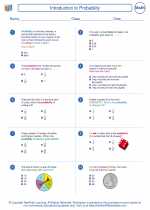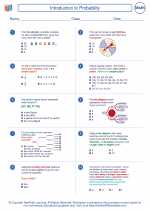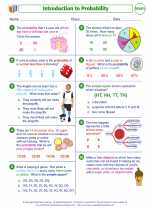Introduction to Probability -> ages
Ages
Understanding how to work with ages is an important part of math. Age problems involve finding the present age, the age of a person in the future or in the past, and comparing ages. Let's explore the key concepts and strategies for solving age-related problems.
Key Concepts:
- Present Age: This refers to the current age of a person or the ages of multiple people at the current time.
- Future Age: This refers to the age of a person at a future point in time, given a certain number of years from the present.
- Past Age: This refers to the age of a person at a previous point in time, given a certain number of years before the present.
- Comparing Ages: This involves comparing the ages of two or more people to determine the age difference between them.
Strategies for Solving Age Problems:
- Setting up Equations: In many age problems, you can use algebraic equations to represent the relationships between ages. For example, if the sum of the ages of two people is 40, you can write the equation x + y = 40, where x and y represent the ages of the two people.
- Using Variables: Assigning variables to unknown ages can help in solving age-related problems. This allows you to create equations and solve for the unknown ages.
- Considering Time Factors: When dealing with future or past ages, it's important to consider the passage of time. You may need to add or subtract a certain number of years to find the future or past age of a person.
- Verifying Solutions: Always check your solutions by substituting the obtained ages back into the original problem to ensure they satisfy all given conditions.
Example Problems:
Here are some example problems to practice the concepts:
- John is 5 years older than Mary. The sum of their ages is 35. How old is each of them?
- In 5 years, Lisa will be three times as old as she was 7 years ago. How old is she now?
- The sum of the ages of a father and a son is 45. Five years ago, the father was 4 times as old as his son. Find their present ages.
Study Guide:
To master the topic of ages, it's important to practice solving a variety of age problems. Focus on understanding the relationships between ages, setting up equations, and using variables to represent unknown ages. Additionally, pay attention to the time factors when dealing with future and past ages. Regular practice and solving different types of problems will help you gain confidence in solving age-related questions.
Remember to always verify your solutions and check that they satisfy all the given conditions in the problem.
Good luck with your studies!
[Ages] Related Worksheets and Study Guides:
.◂Math Worksheets and Study Guides Seventh Grade. Introduction to Probability

 Worksheet/Answer key
Worksheet/Answer key
 Worksheet/Answer key
Worksheet/Answer key
 Worksheet/Answer key
Worksheet/Answer key
 Worksheet/Answer key
Worksheet/Answer key
